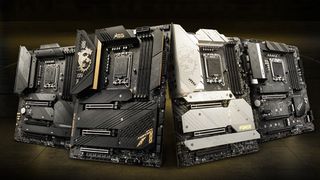For the big four motherboard makers, 2022 will certainly be remembered as an annus horribilis. According to upstream supply chain sources talking to Taiwan’s DigiTimes, the year saw motherboard shipments by Asus, Gigabyte, MSI, and ASRock drastically decline by around 10 million units. The observed “feeble demand” for motherboards spanned the whole year, said the report, and was impacted by the usual suspects; workers returning to the office, the crypto-slump, and the economic downturn.
We have seen some great new motherboard releases in 2022/3 and some impressive new processors, but PC enthusiasts and DIYers seem to be holding back for now. Specifically, Intel’s 700 series LGA1700 motherboards and AMD’s 600 series chipset AM5 motherboards haven’t done the numbers they might have been expected to do. In Intel’s case, this is more understandable as previous-gen motherboards (from Alder Lake systems) can be upgraded to the latest Raptor Lake parts. For AMD it is more concerning as it changed socket last year (after years on AM4), but people held back as it made the upgrade quite an expensive jump (processor, motherboard, and the necessary DDR5 memory).
In its report, DigiTimes shared some figures for the respective big four motherboard makers' 2022 shipments. Some of these Taiwanese brands saw their shipments drop very dramatically.
|
Brand |
2021 Units (M) |
2022 Units (M) |
Percent change |
|---|---|---|---|
|
Asus |
18+ |
13.6 |
-25% |
|
Gigabyte |
11 |
~9.5 |
-14% |
|
MSI |
9.5 |
5.5 |
-42% |
|
ASRock |
~6 |
2.7 |
-55% |
It looks like the biggest two brands have been the least affected by the situation in 2022, but have by no means remained unscathed. Probably the biggest upset is the slide by MSI, which has been gaining a good reputation in recent years but still suffered almost as badly as ASRock.
Lastly, with regard to the above comparison, 2021 still benefitted from some of the positive effects that the pandemic and WFH visited on the tech industry. However, all the 2022 figures were still worse than in 2018 (though we lack MSI motherboard shipment data for 2018). Looking forward to the coming year, most of the brands are expecting to hold, or improve upon, 2022 shipment figures.

Earlier in the week, we reported on some of the grimmest findings about the state of the PC industry we have seen. Mercury Research published a report which stated the PC x86 CPU market has just endured “the largest on-quarter and on-year declines in our 30-year history.” The declines may even be the worst in the history of the PC, but Mercury’s pedigree doesn’t extend that far back in history.
Despite all the gloom, there are still plenty of businesses and commentators looking for a turnaround sometime in mid-2023. We always hope that a new wave of PC sales and upgrades can be inspired by some thrilling new components, and some cut-throat competition would be appreciated too.

